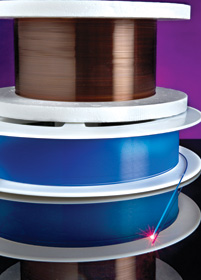Optical fibre for spectroscopic analysis
17 April 2013
Interconnection

Polymicro Technologies, a subsidiary of Molex, has successfully developed a broad spectrum optical fibre with a low -OH pure silica core that demonstrates significantly reduced content of UV defects and other UV absorption centres.
The proprietary FBPI fibre takes advantage of the benefits and mitigates the limitations of standard optical fibres. Featuring improved transmission properties over a much wider spectral range, the silica-based, broadband fibre is available in a range of densities and can be produced in core diameters from 50–600 m.
In the near-infrared (NIR) wavelength region to beyond 2100 nm, Polymicro FBPI fibre attenuation is equivalent to standard NIR fibres having a low -OH silica core and F-doped cladding. Comparable to solarisation properties of standard UV optimised high -OH fibres with high radiation resistance, FBPI fibre features ultra-violet (UV) transmission down to 200 nm.
Many spectroscopic applications require high-performance optical fibres that transmit light over a broad spectrum and demonstrate minimal focal ratio degradation. Unlike standard optical fibres, which are limited by transmission spectral range, Polymicro FBPI optical fibre transmits a wider range of wavelengths with relative uniformity across the wavelength range.
FBPI broadband optical fibre is designed for a range of high performance spectroscopy applications, including optical fibre testing, environmental monitoring, gas phase measurements, precision surgical and industrial lasers and high-performance gas or liquid chromatography.
For more information contact Roger Young, Molex, +27 (0)72 327 1012, [email protected], www.molex.com
Further reading:
Prefitted junction box solutions
Interconnection
Prepopulated junction boxes in popular terminal configurations, such as single- and three-phase, enhance convenience for both electrical wholesalers and contractors.
Read more...
Bulgin unveils new range of sustainable connectors
Avnet Abacus
Interconnection
The Standard Vitalis Buccaneer range of waterproof connectors is a bio-based alternative to Bulgin’s flagship series, the Standard Buccaneer, offering the same technical performance with improved sustainability.
Read more...
Possible copper cable crisis looms as global demand soars
Interconnection
With the world requiring up to 3 billion metric tons of copper by 2050 to support green energy transitions and developing nations’ infrastructure, far exceeding the 23 million metric tons mined in 2024, pressure on supply chains is mounting.
Read more...
High-reliability spring-loaded interconnects
Spectrum Concepts
Interconnection
These springs from Mill-Max are drop-in replacements for the standard springs, requiring no changes to the form or fit of the existing spring-loaded pins.
Read more...
Anoison PCB mount connectors for high-performance applications
Conical Technologies
Interconnection
With its wide selection, Anoison provides PCB mount connectors that combine precision, durability, and cost-effectiveness across industries.
Read more...
Connectors for the Smart Factory
Spectrum Concepts
Interconnection
[Sponsored] Designing networks for the smart factory can seem daunting, but the solutions are already available with Samtec providing a comprehensive range of interconnect technologies tailored to the demands of the modern factory.
Read more...
Mouser shares expert design solutions for advanced robotics development
Interconnection
Mouser Electronics has announced a new interactive eBook, ‘The Electric Workforce’, in collaboration with electronics manufacturer and connectivity innovator, Molex.
Read more...
Explosive zone connectors
Interconnection
The connector series design by Glenair is optimised for fast and easy crimp-contact wire termination, with ample wiring space in the cable housing and accessory hardware.
Read more...
Reliable photovoltaic adapter set
Phoenix Contact
Interconnection
Phoenix Contact’s PV-AS-MC4/6-150-MN-SET1 is a high-performance photovoltaic adapter set designed to bridge SUNCLIX connectors with MC4 connectors.
Read more...
Liquid cooling connectors improve thermal management
Startech Industrial
Interconnection
The leak-free design and high flow rate of both series from Amphenol make the connectors ideal for high-reliability equipment that employ liquid cooling.
Read more...


